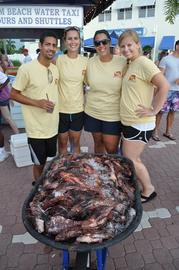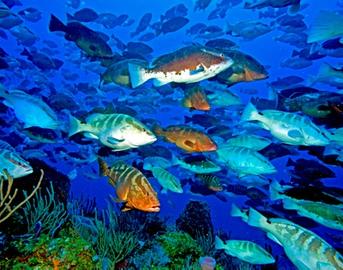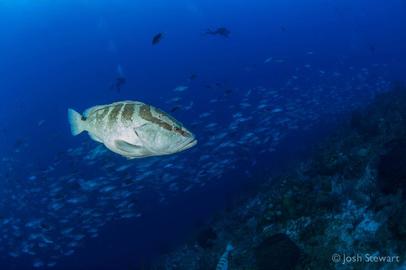Many of you know that REEF helps out sea-dwelling creatures, but you may not know that we also help prepare our future land-dwelling leaders to deal with issues facing our marine ecosystems. Meet the faces of our Marine Conservation Internship Program! Every four months, REEF invites hundreds of applicants to compete for four internship positions. The chosen interns implement community outreach and education programs focused on reef fish identification and lionfish handling and collection. Interns also dive and volunteer with partner organizations in the Florida Keys.
On behalf of the REEF Staff and Trustees, I want to thank all the donors from our Winter Fundraising campaign who helped us reach our target goal. With your help, we can continue REEF's core conservation programs, such as fighting the Lionfish invasion in the Caribbean, protecting Grouper spawning aggregations, collecting data through our Volunteer Fish Survey Project, and providing free online "Fishinars" to the general public and fish experts worldwide.
This paper is part of the larger body of genetic research being conducted on Nassau Grouper in the Caribbean. The authors identified ten polymorphic microsatellite loci for Nassau grouper (Epinephelus striatus) by cross-amplification of loci isolated in Gulf coney (Epinephelus acanthistius). Samples from three geographic localities were scored for these loci –Glovers Reef off Belize (n = 50), Little Cayman (n = 50) and Grammanik Bank in the U.S. Virgin Islands (n = 50). Screening samples yielded 8 to 27 alleles per locus with observed levels of heterozygosity ranging from 0.30 to 0.96.
2010 Our World Underwater Scholar and Grouper Moon researcher, Josh Stewart, recounts his time in the field studying the iconic Nassau Grouper as part of REEF's Grouper Moon Project. The article provides an overview of the research being done and why protecting the Nassau Grouper's spawning aggregations makes sense to ensure the future of the species.
An analysis of how overfishing is altering coral reefs around the world. The author, Grouper Moon researcher Josh Stewart, discusses the plight of aggregating species such as Nassau Grouper as one example and shares his experiences with research being conducted by REEF in the Cayman Islands.
We have a full line-up of dive show appearances planned this year. If you are in the area of one of these shows, please stop by the REEF booth to find out what new and exciting things are happening. In 2013, we will be at: Our World Underwater (Chicago, February 15-17), Beneath the Sea (NJ/NY, March 22-23), Northwest Dive & Travel Expo (WA, April 20-21), and Northern California Dive & Travel Expo (Bay Area CA, May 11-12). We are always looking for volunteers to help at the booth.
Want to get the latest news and updates from REEF? Then be sure to check our the REEF Facebook Page. You don't have to be on Facebook to view the page, anyone can look at the content. If you do have a Facebook profile, be sure to "like" us so that all of the latest information about REEF's programs and events, our marine conservation work, and exclusive content and stories will go straight to your feed.
REEF scientists and volunteers just wrapped up another season of the Grouper Moon Project, a collaborative research effort with the Cayman Islands Department of the Environment (CIDOE). Our research focuses on Little Cayman, which has one of the largest (and one of just a few) known spawning aggregations of Nassau Grouper in the Caribbean. Over 4,000 grouper amass in one location for 7-10 days following winter full moons.
If you haven't yet booked your space on one of our 2013 REEF Field Surveys, don't delay. They are filling up fast. A last minute opening is available on the Fiji trip aboard the Nai'a liveaboard, May 11-21 - we just had a cancellation, so if you want to join REEF Founder Paul Humann, REEF Director of Science Christy Semmens, and a boat full of enthusiastic South Pacific fishwatchers, get in touch with our travel agent at Caradonna right away - 1-877-295-REEF (7333) or REEF@caradonna.com.






